Educators with the New York Transit Museum guided attendees through two centuries of transit history as part of the event, “Sustainability of Public Transportation,” organized by the Office of Alumni Relations.
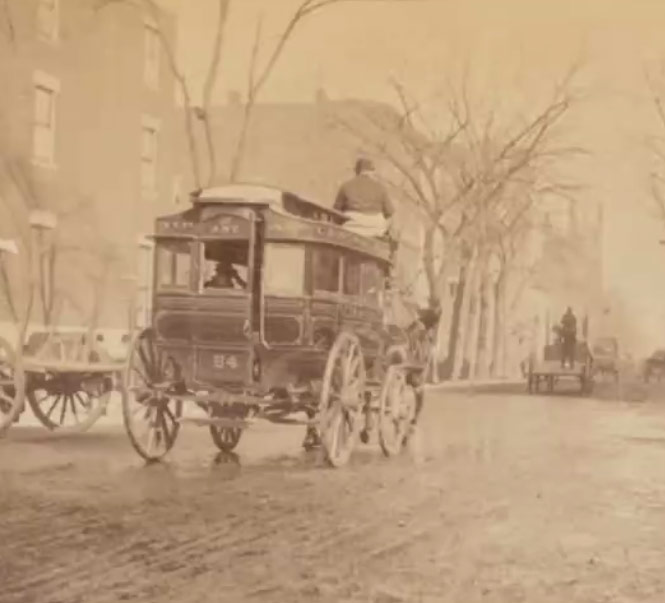
The presentation was framed by themes of economics and environmental and social sustainability. “We’re talking about public transportation systems that should be affordable, efficient, provide access to all, minimize their environmental footprint, and mitigate the effects of climate change,” said Kate Lanceley, an educator with the museum. She spoke—via Zoom—from inside a vintage train car at the museum, housed in a decommissioned subway station in downtown Brooklyn.
Thus began the tour. The first stop? New York City of 1827, a time when public transportation began with horse-drawn omnibuses, which offered bumpy rides on wooden wheels along cobblestone streets. Riders paid about 12 pennies, “which was really a lot of money at the time”—unaffordable for most people, Lanceley said.
Fares were lower, and the ride smoother, in horsecars riding on tracks, which debuted in 1832. But the cars moved slowly, about 8 mph along congested streets, and the horses’ waste “was a massive problem” because no formal department of sanitation existed yet, Lanceley said. While horse-drawn transport would continue, alternatives were on the way.
Steam-Powered Trains Arrive
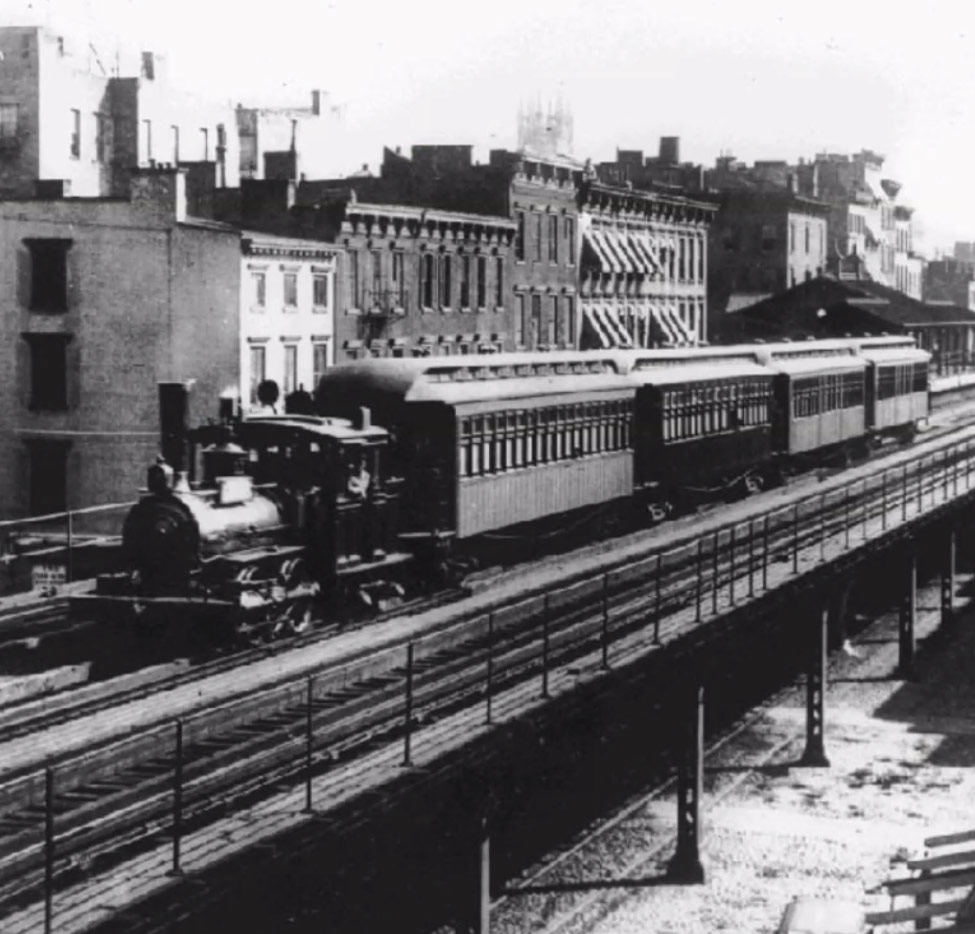
Next, the tour pulled in at New York of the 1870s, when elevated steam-powered trains began service in the city, providing a faster ride—12 to 15 mph along a dedicated right-of-way—and enabling riders to live in spacious uptown areas while commuting to lower Manhattan. But the trains spewed a lot of pollution, blocked the light on city streets, and “were incredibly noisy,” Lanceley said.
And they were vulnerable to the elements—as shown when a blizzard snarled the trains and immobilized riders in 1888. The disaster is credited with catalyzing the formation of a rapid transit commission that examined options for a subway, Lanceley said, adding that some elevated train lines would be incorporated in the subway system.
The First Subway Leaves the Station
Next, the presentation arrived at the founding of the city’s first subway line, built between 1900 and 1904, which began at City Hall and stretched up the east side of Manhattan. Lanceley noted that early trains had overhead fans, “considered a big improvement” at the time. “Today, we look at the fan in horror,” she said. “Imagine if you were really tall and you stretched.”
The subway’s electrified cars were made possible by the same technology that powered streetcars and trolleys, which posed safety concerns as they moved through city streets crowded with pedestrians.
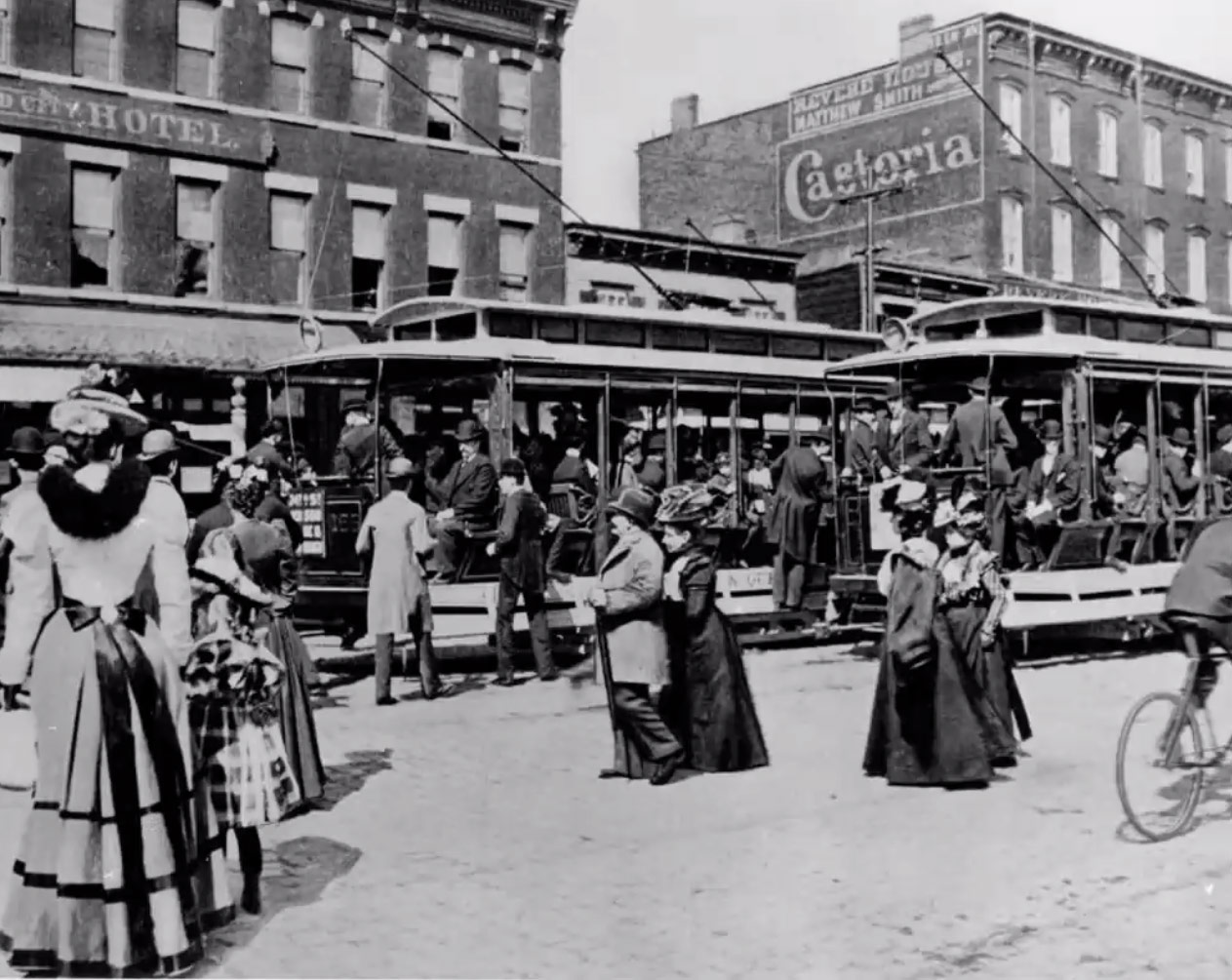
“Everybody is taking their lives into their own hands just crossing the street,” Lanceley said while showing a video from 1903 that appeared to be shot from a moving trolley. In fact, the dodging of streetcars was memorialized in the name of an iconic sports team, the Brooklyn Dodgers, Lanceley noted.
Also essential to the subway’s creation was the 1897 invention of multiple unit control, or putting a motor truck on each car, which allowed more cars to be strung together, since they didn’t all need to be moved by a single engine.
The final stop on the tour was present-day New York, where the work to make the subway system more efficient and accessible continues. The city has begun installing a signaling system using transponders to precisely locate trains so they can run more closely together, allowing more of them to be in service at once, Lanceley said. And the system also faces a formidable task in making all its stations accessible; right now, just 25 percent have elevators, she said.
Climate Change Considerations
Other work on the system highlights the looming issue of climate change, she said, describing upgrades to lower Manhattan subway stations to help them withstand storm surges like the one that devastated the South Ferry station during Hurricane Sandy in 2012.
The hurricane “was really a huge wake-up call for the transit system,” Lanceley said. “Rising sea levels are going to be an ongoing challenge.”
The city is also confronting climate change via changes to the bus system, which was expanded in Manhattan in the 1930s to provide a safer alternative to trolleys, she said. The expected switch to an all-electric city bus fleet by 2040 will not only reduce carbon pollution but also combat that other scourge of New York transit: noise.
That much was clear when she chatted with a driver of one of the new electric buses, Lanceley said: “She really emphasized just how quiet they are, compared with the old noisy diesel buses.”
Alumni attended the event from as far away as Texas and California, taking advantage of the virtual format that alumni relations adopted for cultural and entertainment events with the onset of the coronavirus pandemic. In-person cultural and entertainment events for alumni will resume in the fall, although virtual events will likely continue as well.
]]>
Today, Oct. 29, marks the two-year anniversary of Hurricane Sandy’s widespread devastation in New York and New Jersey. For weeks on end during late 2012, the spring of 2013, and the 2013-14 academic year, students led by Fordham’s Campus Ministry office joined with Habitat for Humanity-Westchester for weekly Sandy Saturdays, to help clear and rebuild neighborhoods in the Far Rockaways and Breezy Point areas.

Oct. 29 marks one year since Hurricane Sandy struck the east coast, causing more than 100 deaths and as much as $65 billion in damages. In New York alone, hundreds were displaced as flooding, severe winds, and, in some cases, fire destroyed entire neighborhoods.
Fordham University is marking the anniversary of Hurricane Sandy with a service trip to help local individuals and families who continue to struggle, and to raise awareness about the continued physical, financial, and spiritual needs of these communities.
On Saturday, Nov. 2, the Fordham University Sandy Solidarity Committee will sponsor its final “Sandy Saturday” to work with affected communities. Volunteers will travel from campus to the Far Rockaways to join Habitat for Humanity in helping clear debris, gut devastated homes, and assist in the ongoing rebuilding efforts.
According to Gil Severiano, assistant to the vice president of campus ministry, the hope was that, by sponsoring a trip near the anniversary of the storm, Fordham could turn a spotlight on the devastation that hurricane victims continue to grapple with.
“There is still a lot of work to be done,” Severiano said. “There are whole lots that are still empty, and people who are have only just begun returning to their homes.”
Since the storm hit, the University has run more than a dozen trips to the Rockaways, Breezy Point, and other affected areas. More than 400 students, staff, faculty, alumni, and friends have participated in these official Sandy Saturdays, although Severiano said the unofficial number is much higher.
“The Fordham response was immediate and sustained,” she said. “In addition to our trips, people were going out in solo groups. The Lincoln Center students, for example, did a phenomenal job of organizing themselves to collect donations and run trips.”
The University will also hold a prayer service Oct. 29 at 6 p.m. on the Gabelli Plaza, outside Hughes Hall. A reception and reflection will be held in the McGinley Ballroom directly following the service.
In addition, the collection at this Sunday’s Mass was dedicated to the hurricane victims.
“Campus Ministry is happy to continue accepting donations on behalf of Catholic Charities, Habitat for Humanity, and others working in these areas. People can also donate directly to these organizations,” Severiano said.
“We live here, these are our neighbors. We need to support our local community.”
To register for Saturday’s trip, click here and fill out the registration form.
For information about either the trip or the prayer service, contact campus ministry at (718) 817-4500.
To read about earlier Sandy Saturday efforts, read the article on Fordham’s news blog.
–Joanna Klimaski

When superstorm Sandy hit on Oct. 29, 2012, the Fordham University community mobilized quickly in coordinating a relief supply hub. Fordham’s involvement did not stop there.
In the last seven months, more than 400 students, faculty, administrators, alumni, and invitees have volunteered through grassroots organizations, and through a series of 11 Sandy Saturday trips sponsored through the University’s Office of Mission and Ministry. The trips were part of an effort by Fordham to help rebuild stricken communities not just through one volunteer day, but through a sustained relationship with Sandy survivors. Volunteers worked closely with Habitat for Humanity Westchester.
“We had such a great response, we literally had to turn students away,” said Sandra Lobo Jost, director of the Dorothy Day Center for Service and Justice.
Volunteers across the University have totaled more than 3,200 hours of community service directed towards hurricane relief. Through collections at University liturgies, individual donations, and campus fundraisers, more than $30,000 was raised for the University’s Disaster Relief Fund to support those affected and organizations and agencies working to assist in the relief and recovery process.
Gil Severiano, a Campus Ministry administrator and a volunteer, said that, unlike other metropolitan-area universities, Fordham’s commitment to Sandy victims was an outgrowth of its Jesuit identity.
“We have been the only university to continue a sustained relationship.”
]]>
Richard Ravitch, former lieutenant governor of the State of New York, andJohn E. Zuccotti, chairman of Brookfield Properties, ended the conference on an up note. Both men cited the two recoveries underway, both 9/11 and Sandy, as examples of the city’s resilience.
Ravitch called New York City an “unbelievably desirable place to live” that is relatively “tax efficient.” He added that the demand for New York real estate will remain strong.
Zuccotti agreed, but expressed concerns for affordable housing for the next generations’ workforce. He said that Chicago and L.A. are no longer the city’s competition, whereas London, Frankfort, Singapore, and Hong Kong are.
GBA Dean Gautschi closed the conference.
“We have to be sure that nostalgia is a kind of comfort, but it can also be a kind of poison, which could be subjected to selected memory,” warned Gautschi.
“We learn by example that cities, too, can die,” he said. “Let’s resolve that this wonderful icon of New York, that means so much to so many, from Paris, to Shanghai, to Kansas City, let’s keep it alive.”
2:00 p.m.
A panel titled “In the Eye of the Storm: Meeting the Challenges of Sandy” featured Carter Strickland, the city’s commissioner of New York City Department of Environmental Protection, and Christopher Levendos, executive director of national operations for Verizon, one of the event’s sponsors.
Strickland laid out the damages of to the city’s water supply and waste water systems. He reminded the crowd that as the much of the city’s water comes from outside city boundaries, NYCDEP had to make monitor 200,000 square miles of watershed land as well.
As the tidal surge essentially traveled up the Hudson river, much of the waste water plants on the river sat in harms way. Nevertheless, NYCDEC employees managed eight million gallons of waste water during the storm, which otherwise would’ve gone into the harbor.
In a riveting account about the damage sustained by Verizon’s headquarters on West Street, Levendos told of flooding in five subbasements which act as an important network hub for communications to much of the city.
“The water didn’t come in in a trickle it came in in a roar,” he said.
In the weeks that followed the roar of water coming in was replaced with the roar of the pumps taking it out. He said the biggest challenge was replacing the fiber optics infrastructure. Much of the equipment in lower Manhattan today has been manufactured over the past 4 months.
Levendos said it took “war time logistics” to complete the job.

The second panel of the day featured two Fordham grads, who are genuine New York power brokers: Patrick Foye, FCRH’78, LAW’81, executive director of the Port Authority of New York and New Jersey, and Kevin Burke, LAW’77, CEO, Consolidated Edison.
Foye addressed an audience that included his predecessor, former Port Authority head Chris Ward. He told them something that many already knew: the storm was the worst transportation disaster that the country had ever seen. He warned that in rebuilding, the city, state, and federal governments should heed the advice given to cadets at West Point: Don’t be like the generals who were always fighting the last war.
The region, Foye said, needs to look beyond Sandy, and not think of it as the worst-case scenario, but as the minimum of what should be prepared for. Burke concurred, but said there are limits to what the city can prepare for, noting that a tsunami would put Lowenstein’s 12th-floor Lounge/Corrigan Conference Center under water, and that is an event that “would be beyond our control.”

One trope that emerged from the conversation was a comparison between 9/11 and Sandy. Burke said that for Con-ed the 9/11 disaster was comparatively limited in scope.
“It was localized,” he said. “We ran cables right on the street, but in Sandy we lost over a million customers.”
Foye said new threats are emerging that must be considered in tandem with other potential disasters, such as cyber attacks. While Sandy may call to mind damage to the physical infrastructure, he suggested a holistic approach should consider all threats, including cyber, that could effect transportation systems and the electrical grid as well.
“Yeserday’s Bulgarian math major is now a state actor,” he said, as Burke nodded in agreement.

Joseph M. McShane, S.J., president of Fordham, launched the Graduate School of Business Administration’s (GBA) Business and the City seminar series this morning, March 5. Sponsored in part by Verizon, “Hurricane Sandy as Inspiration for a ‘New’ New York” looks at designing, building, and funding infrastructure in the post-Sandy metropolis.
“Let us prove that we are doers who meet challenges,” Father McShane told the audience of New York business leaders and urbanists.
Father McShane was followed by David Gautschi, Ph.D., dean of GBA. Gautschi evoked Charles Dickens saying this moment in history could be New York’s tale of two cities: “that of our collective memory and that of how we envision it.”
“This is a thesis conference,” he said.
He added that GBA is committed to picking up the seminar series this fall when it will draw on students from across the university in an attempt to find “common themes and common truths.”
If this conference represented the established point of view, the following conferences would represent “anti-thesis” points of view.
Mike Wallace, Pulitzer Prize-winning co-author of “Gotham: A History of New York City to 1898” then took the opportunity to frame the conversation within the city’s history, telling the crowd New York rebuilders have “winds of history at their backs.”
“There will no doubt be a naysayers,” said Wallace, but he said that even as he spoke the city’s massive water tunnel project is making tremendous strides “underneath our feet.”
The project is, he said, one of the few times the overused term “awesome” is entirely appropriate.
–>
Follow on Twitter w/ @fordhamnotes & @GBAFordham #bizNYC. Follow the livestream at bit.ly/YauACI
In the aftermath of Hurricane Sandy, the New York metropolitan area needs to prepare for a future that many experts believe will see a greater frequency of powerful storms, resulting in unprecedented levels of flooding and damage. Proposed solutions are wide-ranging, from installing a series of massive tidal gates and barriers across New York Harbor to smaller-scale approaches such as waterproofing transportation tunnels and utility plants through use of high-tech pumping systems and raised ventilation stacks.
At the same time, there is growing consensus that the region’s building code must be significantly updated to require, for example, installation of advanced waterproofing systems to ensure survival of electrical and communications infrastructures under extreme conditions. Basic questions must also be addressed, such as how to protect the office infrastructure of downtown Manhattan, hospital complexes along the East River, and waterfront communities across the 5 boroughs.
GBA’s new Business and the City series and Fall 2013 seminar will seek to engage students from across Fordham University with community ‘fellows’ to explore how business can influence the infrastructure of the city through its interaction with the arts, education, and commerce.
Speakers include:
• Richard Ravitch, former NY State Lt Governor, former Chairman, MTA
• Patrick J. Foye, Executive Director, Port Authority of New York & New Jersey
• Cas Holloway, Deputy Mayor for Operations, City of New York
• Kevin Burke, Chairman, President & CEO, Consolidated Edison
• Christopher Levendos, Executive Director of National Operations, Verizon
• John Zuccotti, Co-Chairman, Brookfield Office Properties
• Mike Wallace, Pulitzer Prize-winning co-author of “Gotham: A History of New York City to 1898”
• Carol Kellermann, President, Citizens Budget Commission
• Lee Sander, Chairman of the Regional Plan Association; President and CEO, HAKS Group; former Executive Director and CEO, MTA
• Nicole Gelinas, Searle Freedom Trust Fellow, Manhattan Institute; Contributing Editor, City Journal
• Abraham M. Lackman, President, Praxis Insights, former Budget Director, City of New York, Scholar in Residence, Fordham University
Limited seating, advance registration required.
Registration fee (includes continental breakfast and lunch): $25 / $10 student rate.
For more information, contact Felicity Crew at [email protected].
]]>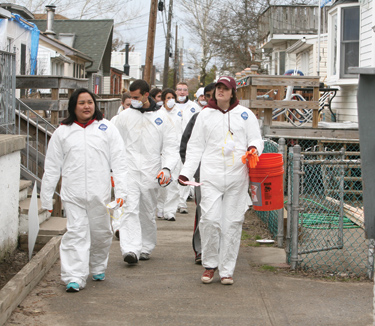
Photo by Bruce Gilbert
Since the hurricane, the University at large has been collecting donations, distributing goods, and volunteering to help communities affected by Sandy.
“On every level, the Fordham community has been and remains compassionately generous in responding to the extraordinary tragedy to be remembered forever simply as ‘Sandy,’” said Msgr. Joseph G. Quinn, vice president for University mission and ministry. “In prayer, donations, and kindnesses beyond counting, Fordham is striving to care for its neighbors whose lives have been so sadly upended by the devastation of this disaster.”
In addition to raising more than $25,000 in donations, groups of students, faculty, and staff have made several trips to affected communities, and more projects are scheduled throughout the spring semester.
In early January, a group of 11 students traveled to Breezy Point, Queens as part of a weeklong Global Outreach (GO) NYC trip. After working with the Bronx’s Part Of The Solution (POTS) program and bringing food to homeless individuals, the group spent a day in Breezy Point working on demolition and construction in houses that had been severely damaged by the storm.
“It was an intense experience for everyone, but it was also good to get out there and learn about what’s going on,” said Fordham College at Rose Hill senior Laura Buckley, who led the GO NYC trip. “There’s still much to be done.”

On Jan. 11, more than 90 resident assistants (RAs) and resident directors devoted a day of the winter RA training schedule to join Operation Blessing, a nonprofit international relief and development corporation working in Breezy Point.
The group helped clear debris, remove remnants from both the beach and a Sept. 11 memorial, and communicate with residents regarding their remaining needs.
“This horrible tragedy of Hurricane Sandy isn’t something that’s going to be remedied in the two weeks after it happened,” said Kim Russell, director of Residential Life. “You wouldn’t know that this storm happened months ago—it’s still pretty devastating there.”
Following the trip, many RAs expressed interest in returning to the area with the students who live on their floors, Russell said.
The Dorothy Day Center for Service and Justice has organized a series of one-day outings known as “Sandy Saturdays” on the following dates: Feb. 9, Feb. 23, March 9, March 23, April 6, and April 20.
Volunteers will leave from the Rose Hill campus and travel to Breezy Point and the Far Rockaways to join Habitat for Humanity and other organizations already working in the area. Transportation and meals will be provided.
Fordham is requesting the help of faculty, staff members, and administrators to chaperone on the outings. Academic departments and University offices can also volunteer to sponsor one of the six remaining Saturdays.
Interested volunteers should contact the Dorothy Day Center for Service and Justice at (718) 817-4510.
“The Fordham family will continue to do all it can to ease the suffering, help carry the burdens and aid others in restoring their homes, their communities, and their lives,” Msgr. Quinn said.
]]>
More than two months after Hurricane Sandy struck the east coast, many local families are still struggling to rebuild their homes and lives. In an effort to help those affected, Fordham University continues to sponsor a series of one-day outings known as “Sandy Saturdays” to work with affected communities.
Volunteers will travel to Breezy Point and the Far Rockaways to help clear debris, gut devastated homes, and assist in the beginnings of the rebuilding efforts. Groups will join Habitat for Humanity, Operation Blessing, the St. Francis de Sales Elementary School, and other organizations already working in the area.
To learn about the volunteers’ Jan. 26 experience, read the article on Fordham’s news blog
Remaining Sandy Saturdays are set for:
- March 23
- April 6
- April 20
Volunteers will depart from Fordham at 7:30 a.m. and, following a full day’s labor, will return to Fordham by 5 p.m. Transportation and meals will be provided.
“Sandy Solidarity calls out the entire Fordham family to live with a true spirit of compassion, to truly live out our Fordham mission in this time of ongoing need,” said Monsignor Joseph G. Quinn, vice president for University mission and ministry.
Fordham is requesting the help of faculty, staff members, administrators, and friends of the Fordham community to chaperone students on the outings. Anyone interested in either chaperoning or volunteering should contact the Dorothy Day Center for Service and Justice at (718) 817-4510 or by going online here.
More information about additional trips and ongoing relief efforts will be provided in a forthcoming Inside Fordham article.
]]>Administrative offices across the University—from the deans’ offices to Campus Ministry and the Dorothy Day Center for Service and Justice—determined how to best help students, staff and faculty affected by Sandy.
“We’re trying to respond compassionately to the needs of those members of the Fordham family who have been so deeply impacted by this storm,” said Msgr. Joseph G. Quinn, vice president for University Mission and Ministry, whose office is leading a multifaceted response to post- hurricane recovery efforts.
Regarding its students, Fordham was immediately proactive, said Michele Burris, associate vice president for student affairs.
“We did a search to see who lived in the areas that were really affected, and we reached out to those students to just ask, ‘Hey, are you doing alright? Let us know what you need,’” she said. Students were offered health services, counseling services, or whatever they needed to cope with their situations.
According to the deans’ offices, 71 students attending the Lincoln Center and Rose Hill campuses lost power, water, or heat following the storm. The Office of Residential Life housed any student that needed shelter in campus dormitories. For many students, power—and with it, normal life—was restored within two weeks of the hurricane’s landfall.
Students who lost their homes during the storm have been given housing on campus for the rest of the semester, paid for by an emergency fund.
Matthew White, GSB ’09, has been staying in McMahon Hall ever since the hurricane flooded his home in Rockaway Park.
“They got in touch with me the week of the storm, which was pretty impressive, because I was shoveling sand and making sure my family was okay,” said White, a student in the Graduate School of Business Administration. “I’m more than proud to say that Fordham helped me out in a time of huge need.”
In the five weeks following Sandy, more than $16,000 has been collected at Sunday Masses, interfaith prayer services, and various student activities toward a relief fund set up by the Office of the President. Non-monetary donations have also poured in.
Campus Ministry and the Dorothy Day Center have begun volunteer trips to hard-hit areas. On Nov. 17, a group of 22 students and five staff traveled to Breezy Point to aid Habitat for Humanity in the ongoing relief efforts.
“We did everything from demolition to moving debris to cleaning a public space so that the people could host a fundraiser,” said Conor O’Kane, associate director of Campus Ministry at Rose Hill.
Campus Ministry continues to fill bins with items that are still needed by those affected, said Msgr. Quinn. Students transport the items to local distribution sites, such as the Kingsbridge Armory in the Bronx.
 The day after Sandy hit the metropolitan area, FCLC sophomore Chris Hennessey and FCLC junior Jaime Rodriguez spearheaded a spontaneous effort at the McMahon dorms on the Lincoln Center campus, which they dubbed Occupy 109. The students organized a canned food drive in the dorm’s community room and launched the Facebook page, FCLC Hurricane Sandy Response. With the support of Maureen O’Connell, Ph.D, associate professor of theology, the effort grew in size with each passing day.
The day after Sandy hit the metropolitan area, FCLC sophomore Chris Hennessey and FCLC junior Jaime Rodriguez spearheaded a spontaneous effort at the McMahon dorms on the Lincoln Center campus, which they dubbed Occupy 109. The students organized a canned food drive in the dorm’s community room and launched the Facebook page, FCLC Hurricane Sandy Response. With the support of Maureen O’Connell, Ph.D, associate professor of theology, the effort grew in size with each passing day.
“We had a moral obligation to be there,” said Hennessey.
 On Friday morning, Nov. 2, an additional 20 volunteers joined the effort to carry armfuls of supplies onto MTA busses heading into the powerless sections of lower Manhattan. By Saturday morning the number of volunteers had swelled to 60, said Rodriguez.
On Friday morning, Nov. 2, an additional 20 volunteers joined the effort to carry armfuls of supplies onto MTA busses heading into the powerless sections of lower Manhattan. By Saturday morning the number of volunteers had swelled to 60, said Rodriguez.
By that time McMahon Room 109 had become something of a command center after the local public school could no longer accept donations. Hennessey put a sign up at the school directing donations to the dorm, making McMahon the de facto distribution center for the Upper West Side. Neighbors signed on to help, with one family from the Time Warner building lending their car. Volunteers arrived from Maryland to Massachusetts, said Hennessey.
 After the lights went back on downtown, the focus shifted to the outer boroughs. Using the Occupy Sandy website, the crew developed an online reputation for their specificity. In one case, a Brooklyn family requested a stroller and the group managed to get it to them later that day. A request for Pediasure, the children’s nutrition drink, was met after students secured a large donation of several cases from Duane Reade.
After the lights went back on downtown, the focus shifted to the outer boroughs. Using the Occupy Sandy website, the crew developed an online reputation for their specificity. In one case, a Brooklyn family requested a stroller and the group managed to get it to them later that day. A request for Pediasure, the children’s nutrition drink, was met after students secured a large donation of several cases from Duane Reade.
Social media drove many of the responses among the Fordham community. Mark Naison, Ph.D, professor of African and African American studies, put out a call for help on his Facebook page to assist Kendra Newkirk, FCRH ‘00, one of his former students. Newkirk had just moved into a new home in the Rockaways with her two small children. On Nov. 18, A group of Fordham alumni and Facebook friends joined Naison to help remove everything from Newkirk’s house so that FEMA could inventory what was lost.
“Kendra had her housewarming party on Sunday and the place was destroyed on Monday,” said Naison, who said seeing Sandy’s mass destruction was quite a depressing experience. “There were six of us and it took us four hours to carry every single possession that Kendra had out into the front yard. Clearly, the home was decorated with great love.”
Newkirk, who is now staying with her mother in the Bedford Stuyvesant section of Brooklyn, is an assistant director of a daycare in the Rockaways that also sustained damage.
With the community displaced, there is little chance the daycare will reopen anytime soon, she said.
“My heart is so burdened,” said Newkirk. “I have a family that I can stay with, but there are lots of people out there who don’t have that.”
Newkirk said that the cleanup would not have been possible without the help.
“It was just phenomenal. These are people I’ve never met,” she said. “I definitely didn’t anticipate the mental and spiritual support that I got. I didn’t expect that at all.”
O’Kane said that students, faculty, and staff who would like to volunteer are encouraged to visit Campus Ministry’s website, which will be updated daily with volunteer opportunities.
“This will be a very long process and I think the heart of Fordham’s responsibility to our neighbors and our brothers and sisters is to cultivate a critical awareness of that, especially when it begins to fade from the news cycle,” he said.
Joanna Klimaski and Tom Stoelker contributed to this report. To donate to the Disaster Relief Fund, visitwww.fordham.edu/mission/mission_and_ministry/campus_ministry.
]]>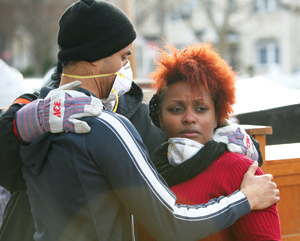
Photo by Bruce Gilbert
Though Fordham campuses were largely spared, Hurricane Sandy still upended the lives of many in the University community. Faculty, administrators and students launched a variety of relief efforts to assist those in need.
Administrative offices across the University—from the deans’ offices to Campus Ministry and the Dorothy Day Center for Service and Justice—determined how to best help students, staff and faculty affected by Sandy.
“We’re trying to respond compassionately to the needs of those members of the Fordham family who have been so deeply impacted by this storm,” said Msgr. Joseph G. Quinn, vice president for University Mission and Ministry, whose office is leading a multifaceted response to post- hurricane recovery efforts.
Regarding its students, Fordham was immediately proactive, said Michele Burris, associate vice president for student affairs.
“We did a search to see who lived in the areas that were really affected, and we reached out to those students to just ask, ‘Hey, are you doing alright? Let us know what you need,’” she said. Students were offered health services, counseling services, or whatever they needed to cope with their situations.
According to the deans’ offices, 71 students attending the Lincoln Center and Rose Hill campuses lost power, water, or heat following the storm. The Office of Residential Life housed any student that needed shelter in campus dormitories. For many students, power—and with it, normal life—was restored within two weeks of the hurricane’s landfall.
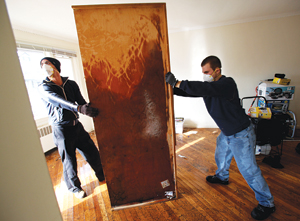
Photo by Bruce Gilbert
Students who lost their homes during the storm have been given housing on campus for the rest of the semester, paid for by an emergency fund.
Matthew White, GSB ’09, has been staying in McMahon Hall ever since the hurricane flooded his home in Rockaway Park.
“They got in touch with me the week of the storm, which was pretty impressive, because I was shoveling sand and making sure my family was okay,” said White, a student in the Graduate School of Business Administration. “I’m more than proud to say that Fordham helped me out in a time of huge need.”
In the five weeks following Sandy, more than $16,000 has been collected at Sunday Masses, interfaith prayer services, and various student activities toward a relief fund set up by the Office of the President. Non-monetary donations have also poured in.
Campus Ministry and the Dorothy Day Center have begun volunteer trips to hard-hit areas. On Nov. 17, a group of 22 students and five staff traveled to Breezy Point to aid Habitat for Humanity in the ongoing relief efforts.
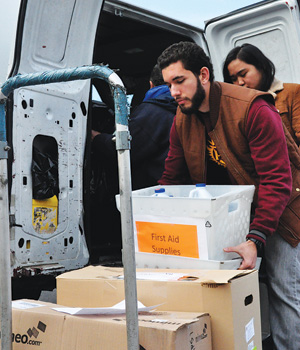
Photo by Joanna Klimaski
“We did everything from demolition to moving debris to cleaning a public space so that the people could host a fundraiser,” said Conor O’Kane, associate director of Campus Ministry at Rose Hill.
Campus Ministry continues to fill bins with items that are still needed by those affected, said Msgr. Quinn. Students transport the items to local distribution sites, such as the Kingsbridge Armory in the Bronx.
The day after Sandy hit the metropolitan area, FCLC sophomore Chris Hennessey and FCLC junior Jaime Rodriguez spearheaded a spontaneous effort at the McMahon dorms on the Lincoln Center campus, which they dubbed Occupy 109. The students organized a canned food drive in the dorm’s community room and launched the Facebook page, FCLC Hurricane Sandy Response. With the support of Maureen O’Connell, Ph.D, associate professor of theology, the effort grew in size with each passing day.
“We had a moral obligation to be there,” said Hennessey.
On Friday morning, Nov. 2, an additional 20 volunteers joined the effort to carry armfuls of supplies onto MTA busses heading into the powerless sections of lower Manhattan. By Saturday morning the number of volunteers had swelled to 60, said Rodriguez.
By that time McMahon Room 109 had become something of a command center after the local public school could no longer accept donations. Hennessey put a sign up at the school directing donations to the dorm, making McMahon the de facto distribution center for the Upper West Side. Neighbors signed on to help, with one family from the Time Warner building lending their car. Volunteers arrived from Maryland to Massachusetts, said Hennessey.
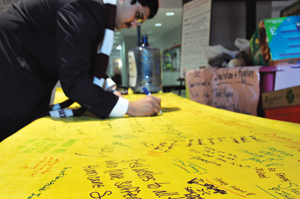
Photo by Joanna Klimaski
After the lights went back on downtown, the focus shifted to the outer boroughs. Using the Occupy Sandy website, the crew developed an online reputation for their specificity. In one case, a Brooklyn family requested a stroller and the group managed to get it to them later that day. A request for Pediasure, the children’s nutrition drink, was met after students secured a large donation of several cases from Duane Reade.
Social media drove many of the responses among the Fordham community. Mark Naison, Ph.D, professor of African and African American studies, put out a call for help on his Facebook page to assist Kendra Newkirk, FCRH ‘00, one of his former students. Newkirk had just moved into a new home in the Rockaways with her two small children. On Nov. 18, A group of Fordham alumni and Facebook friends joined Naison to help remove everything from Newkirk’s house so that FEMA could inventory what was lost.
“Kendra had her housewarming party on Sunday and the place was destroyed on Monday,” said Naison, who said seeing Sandy’s mass destruction was quite a depressing experience. “There were six of us and it took us four hours to carry every single possession that Kendra had out into the front yard. Clearly, the home was decorated with great love.”
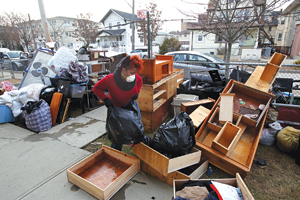
Photo by Bruce Gilbert
Newkirk, who is now staying with her mother in the Bedford Stuyvesant section of Brooklyn, is an assistant director of a daycare in the Rockaways that also sustained damage.
With the community displaced, there is little chance the daycare will reopen anytime soon, she said.
“My heart is so burdened,” said Newkirk. “I have a family that I can stay with, but there are lots of people out there who don’t have that.”
Newkirk said that the cleanup would not have been possible without the help.
“It was just phenomenal. These are people I’ve never met,” she said. “I definitely didn’t anticipate the mental and spiritual support that I got. I didn’t expect that at all.”
O’Kane said that students, faculty, and staff who would like to volunteer are encouraged to visit Campus Ministry’s website, which will be updated daily with volunteer opportunities.
“This will be a very long process and I think the heart of Fordham’s responsibility to our neighbors and our brothers and sisters is to cultivate a critical awareness of that, especially when it begins to fade from the news cycle,” he said.
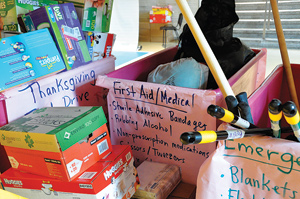
Photo by Joanna Klimaski
Joanna Klimaski and Tom Stoelker contributed to this report. To donate to the Disaster Relief Fund, visit http://www.fordham.edu/info/20094/campus_ministry
]]>Fordham Disaster Relief Fund
Office of the President
441 E. Fordham Road
Fordham University, Bronx, NY 10458
For more information on how to donate or volunteer, click on the dedicated web page here:
]]>